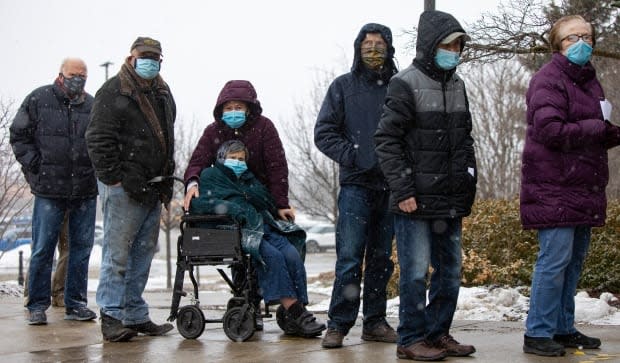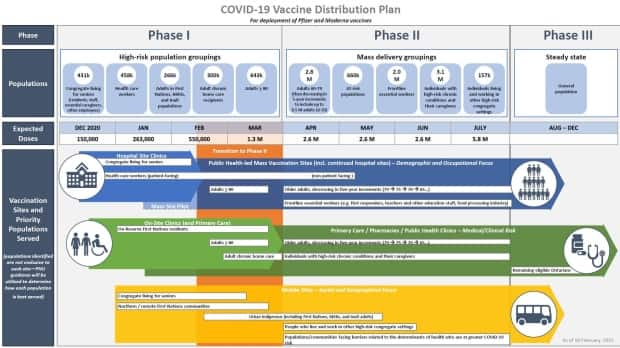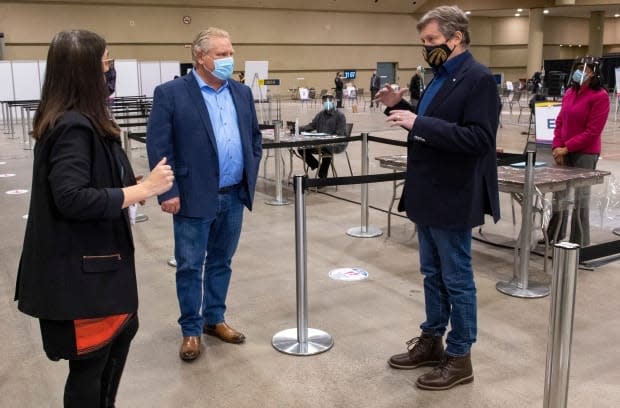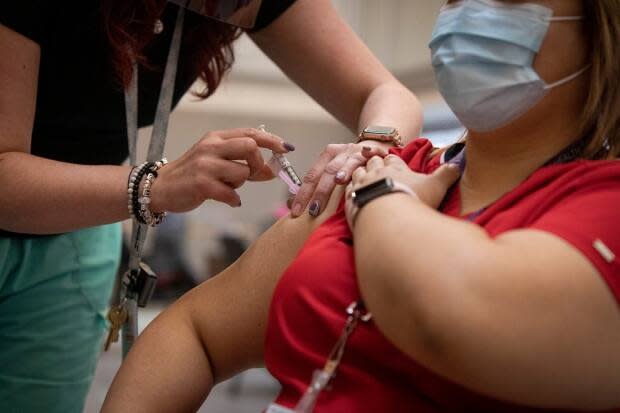Why Toronto's COVID-19 vaccination rollout is slower than other Ontario cities

The rollout of COVID-19 vaccinations in Ontario is happening at 34 different speeds, with each public health unit taking its own approach.
The pace in the province's largest public health unit is notably slower than average. Officials in Toronto can't say when people aged 80 and up will be eligible to get vaccinated and are urging people not to call the public health hotline with questions about the timeline.
Meanwhile, several public health units covering large urban areas have already started giving shots to that age group.
York Region and Windsor-Essex both began their vaccinations of 80-plus-year-olds on Monday. In York Region, 20,000 of the roughly 45,000 people eligible have already booked appointments.

During a City of Toronto news conference on Monday, officials were asked specifically when people in this age group in can expect to get the shot. There was no clear answer.
Medical officer of health Dr Eileen de Villa spoke for two and a half minutes without addressing the question.
WATCH | Questions and concerns continue around the timeline for Ontario's COVID-19 vaccine rollout:
Next, Fire Chief Matthew Pegg, leading Toronto's COVID-19 emergency response, said bookings would begin once the province's appointment system launches (slated for March 15), and added that vaccinations would begin in "early April."
De Villa then jumped in to say that vaccinations of some sub-groups of people in this age group could begin this month, but added, "We need supply to be more readily available to get into the large-scale administration of vaccine for that 80-plus population."
Given that all of Ontario's public health units are facing the same supply constraints, why is Ontario's largest city weeks behind other major population centres in the province?

The chair of Toronto's board of health, Coun. Joe Cressy, blames a vaccine allocation mismatch: the province is distributing doses to each public health unit based solely on its total population, not based on its population in the high-priority groups.
In short, the argument is that Toronto is hampered from moving on to vaccinate seniors aged 80 and older because it has yet to receive enough doses to vaccinate those who were first in line -- such as hospital workers.
"We have a disproportionately large number of people who qualify in phase 1 because they are more vulnerable," Cressy told the news conference.
That leads to a question: why didn't the province provide a larger number of vaccines to places with a larger number of people in priority groups?
Solicitor-General Sylvia Jones acknowledged Tuesday that Toronto's explanation for its slower pace "makes sense." But when asked whether the province should have distributed doses on an as-needed basis instead of a per-capita basis, she didn't directly answer.

"The focus on the over 80 (age group) is critical," Jones told a news conference. "We'd love to have more vaccines to give to our public health units."
Just don't ask the provincial government how many vaccine doses it has actually given to its public health units. The Ministry of Health refused CBC's request for this data on Tuesday, citing security concerns.
The government also refused to provide a breakdown of how many vaccine doses have been administered by each public health unit, even though the ministry reports a province-wide total every day.
The lack of disclosure makes it challenging to prove or disprove the claim that the distribution of vaccines has been unfair to Toronto.
However, some figures disclosed by health units allow for rough math. The Haldimand-Norfolk Health Unit says it has received 12,285 doses of vaccine, while Toronto has received 195,440 doses.
Using population data from Public Health Ontario, those shipments are enough to give one dose to 10.8 per cent of people living in Haldimand-Norfolk, but just 6.3 per cent of the population of Toronto.

What is less clear is the evidence for Toronto's claim of being home to a disproportionate number of people in the priority groups for vaccination.
People aged 80 and over are part of phase 1 of Ontario's vaccination timeline. But before getting to them, public health units were told to target the province's top-priority categories: long-term care residents and staff, other front-line health-care workers and Indigenous people.
Ontario estimates 1.15 million people belong to those highest-priority groups. That is roughly eight per cent of the province's total population.
Toronto Public Health could not provide an estimate Tuesday of how many people in the city are in those top-priority groups. But for Toronto to have a disproportionate burden, the number would need to be more than 240,000.
Another comparison stick is the number of people eligible for vaccination through the whole of phase 1. Toronto Public Health says it's 325,000 people in the city, roughly 11 per cent of Toronto's population. That is no higher that the proportion of Ontario's population eligible in phase 1.
Toronto Public Health COVID-19 vaccination numbers
195,440 doses of vaccine have been shipped to Toronto
around 325,000 people are eligible to be vaccinated in phase 1
around 135,000 of them are aged 80 and above, including some 10,000 residents of long-term care

